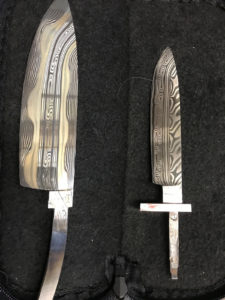
For most people the word “blacksmith” brings up thoughts of someone in the pioneer days making nails or shoeing a horse. Yet, for Tom Ward, MFA student at Southern Illinois University Carbondale, blacksmithing holds a very different meaning.
With a specialization in ancient weaponry, Ward spends most of his time carefully constructing blades, swords and daggers that resemble prehistoric pieces. From the forging of the metal to the carving of the wood, Ward creates each intricate piece by hand.
Meticulously creating each piece

When Ward first started his journey in design, he kept feeling that something was tactically missing for him. It was not until he took a class in bladesmithing that he finally found his niche. He joined the only master’s level blacksmithing program in the nation at SIU, and now creates pieces that give a peek into times past.

Every piece starts from basic materials, Ward explained. A single project can take anywhere from three days to a whole semester of work. The average time for a medium size blade usually averages around two weeks.
“I use different densities of layered materials,” Ward said. “I layer material up and then through heat and pressure I fuse them together. I then manipulate that to create surface effects on the metal in a very deliberate way.”
Then, Ward forges the pieces in the fire, according to the specific design plan.
“My actual time in the fire is pretty minimal,” Ward said. “The rest of it is material removal through grinding, cutting and sanding, until I get to the finished product. It really requires me to be a jack of all trades.”

Within the process, Ward also does a lot of machining using precision tools. While his focus is in blacksmithing, a large portion of his work requires more fine detailed work, similar to that of a bench jeweler.
“Everything that I make has a functional base to its core,” Ward said. “Its functionality is never compromised by also being an aesthetic piece.”
Getting a taste of ancient history

For Ward, recreating the weapons is an important way to understand past techniques, technologies and lifestyles. Up until the time of the industrial revolution, steel and iron production was very difficult. For about 2,500 years, people were not very good at it, Ward explained. Yet, they still made incredible things from it.
“While our society no longer has a need for these kind of pieces, they give you a viewpoint into the past,” Ward said. “It is a sort of delve into experiential archeology.”
Although steel tariffs and trade wars still affect our economy today, the metals made an even larger impact on the ancient world.
“The history of steel is a major driving force in the history of the world,” Ward said. “The ancient countries that first began to use iron and steel very quickly conquered large surrounding areas and either militarily or economically control vast swaths of the world.”
Embracing SIU’s rich blacksmith history
Before coming to SIU, Ward was in metals production making architectural pieces and working with hundreds of linear feet of material. He decided to take some time to focus on individual artistic pieces, and now exhibits his work at tradeshows and hopes to one day teach in an academic setting.
As one of the most prominent blacksmithing programs in the world, SIU was an easy choice for Ward. Yet, more than just popular and affordable, Ward really picked this program because of its rich history with blacksmithing.
“The revival of blacksmithing in America happened here,” Ward said. “If it wasn’t for this shop at SIU, no modern metalsmith in America would be doing what they do.”
Much of this is due to several alumni, who brought unique practices to SIU such as mokume-gane, a Japanese metalworking procedure.
“Blacksmithing and metals work at SIU have a very rich history, and I feel honored to be a part of that,” Ward said.





